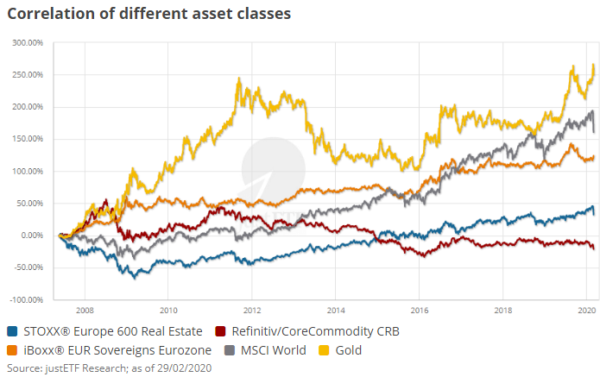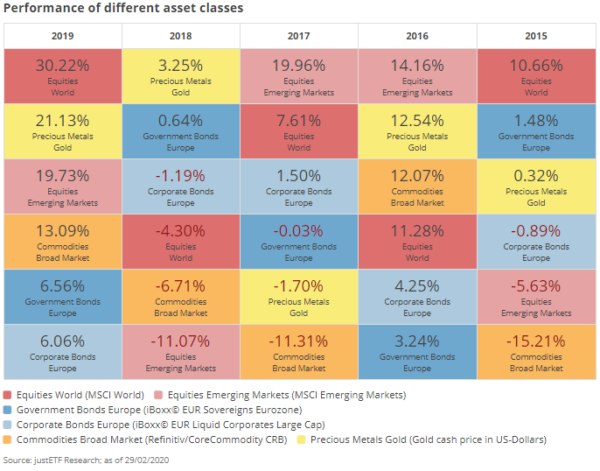Apr
2023
Asset Allocation: choosing the right asset mix for your ETF portfolio
DIY Investor
18 April 2023
How to think about asset allocation
The goal of asset allocation is to combine complementary assets so that you can withstand market shocks and achieve the growth you need over time. The first step in creating your asset allocation is to understand the role of each asset class:
Equities are your long-term growth drivers that can be expected to outperform other asset classes when the economy thrives. High-quality government bonds are often a safe haven during recessions. Commodities have historically protected portfolios during times of stagflation. Gold comes into its own when the market fears an existential crisis and currency devaluation, as loomed large in 2008-2009. Real estate offers some inflation resistance over the long term and sits in the middle ground between equities and bonds.
Essentially, your asset classes are members of a team and your asset allocation is your gameplan for harnessing their individual abilities to achieve your overall goal.
The chart below shows how different asset classes have counterbalanced each other in the past.

You can see the Global Financial Crisis unfold in 2008 as world equities and real estate slump. Commodities prospered initially before declining steeply; Eurozone government bonds held the line despite the sovereign debt crisis, while gold proved to be the star performer during the crisis and its aftermath.
Gold falls from 2013 to 2016 but its decline is offset by the continuing recovery of equities, property and rising confidence in bonds. Ultimately you can see that gold and equities tended to be negatively correlated during these years; real estate and equities mirrored each other; bonds offered low volatility, while commodities had some years to forget after overperforming prior to 2008.
Sure, you’d be incredibly wealthy if your portfolio only ever contained the winning asset class of the moment, but can you predict which one that is going to be?
Today’s winners are tomorrow’s losers
The table below shows you how unpredictable asset class performance is. Can you spot a pattern?

Developed Markets equities topped the table in both 2015 and 2019 and were second in 2017 but fell to mid-table in between. Not bad. Gold stayed in the top 3 throughout, except when it didn’t: finishing second from bottom in 2017.
To some extend, commodities were the opposite of gold, finishing bottom 3 in all years other than 2016. Emerging markets lived up to their volatile reputation by being (second-to-)last in 2015 and 2018 and first in the years between.
As ever, the past tells us nothing about the future. Buying a losing asset class at bargain prices can pay off handsomely when it jumps to the top of the table.
This is sometimes termed mean reversion – the market realises it has undervalued an asset class and demand rises as investors’ faith is restored. This happens in reverse too: an asset class can be dumped like a radioactive waste when the market believes its overvalued. Market bubbles inflate and pop during the most extreme periods of this behaviour.
Hence asset classes flip from zero to hero at different times and leveraging this variance is the key to successful asset allocation. By accepting that you can’t predict the winners, or time the market, but are better off diversifying across the most useful asset classes, you create a portfolio that’s more than the sum of its parts. In other words, you can achieve a lower overall level of risk per unit of return by smoothing your results over time across complementary asset classes.
The nightmare scenario that good asset allocation helps us to avoid is two-fold. Firstly, trapping our wealth in a single asset class that ends up having a lost decade. Secondly, banking everything on asset classes that are so volatile they cause us to panic and sell out at the bottom of the market. That makes your asset allocation the most important investment decision you’ll make.
Determine your strategic asset allocation
Strategic asset allocation refers to the decision of how to split your portfolio between risky assets (like equities) and defensive assets (like high-quality bonds and cash). According to numerous academic studies, strategic asset allocation accounts for 90% of the variation in portfolio returns, so it’s important to get it right.
Diversification spreads your risks across the key asset classes but your goals and risk tolerance determine your individual asset allocation.
To optimise your asset allocation for your specific situation you should think about:
Investment horizon
If you’ll invest for many years before drawing down on your wealth you can afford to put more into equities. That enables you to take advantage of equities’ higher expected returns versus other asset classes while being able to wait out any stock market turbulence along the way.
If you need your money back in a few years, however, you should avoid equities and look at short-term UK government bonds or cash. These are the least volatile asset classes that will best preserve your wealth over short periods.
Risk tolerance
What’s relevant here is how much risk you are willing, able and compelled to take.
Willing – some investors can coolly shrug off large stock market losses without worrying about it. If that’s really you (perhaps you weren’t bothered by the 2008 meltdown) then you can allocate more than normal to equities. If the late 2018 pullback caused you to sweat then you shouldn’t venture too much to volatile asset classes like equities, real estate and commodities.
Able – if you don’t need the money then ironically you can afford to take more risk in the hope of a big pay off. But if you’re absolutely relying on your portfolio to pay the bills in the future then you should increase your allocation to less volatile bonds as that time approaches.
Compelled – Your calculations may show that you need an annualised 4% real return per year to achieve your goals in ten years. The chances of achieving this with just bonds or cash are slim to none. Therefore a strong need requires a higher allocation to riskier assets. Note, however, that investing isn’t a game where you want to play a Hail Mary pass. If you’re relying on a decade of 10% annualised real returns then you need a miracle. Alternatively, you can do something more sensible like invest for longer or contribute more to your portfolio.
Lifecycle
Young investors generally have little of their financial capital committed to the market in comparison to their human capital i.e. their capacity to work for many years into the future and recover from any mistakes or market turmoil.
Older investors by contrast usually have more financial capital but less human capital and fewer years left to rectify losses.
That truism has led to the following rule-of-thumb for portfolios that will ultimately fund your retirement:
So a 30-year-old has 70% of her portfolio in equities and 30% in bonds. A 40-year-old has 60% of her portfolio in equities and 40% in bonds. And yes, a 60-year-old has 40% of her portfolio in equities and 60% in bonds. Each year, you’d sell 1% of your equities and buy an extra 1% in bonds as part of your rebalancing process.
Real estate and broad commodities may come out of your equities allocation but should be limited to 5-10% each. Cash and gold come out of the bond side, but limit gold to a 5-10% block. Your bond allocation should be restricted to high-quality bonds. High-yield bonds are closer to equities in nature and should come from the risky side of the equation.
Your final asset allocation should balance the trade-offs inherent in the dimensions listed above to suit your particular needs. If you would like to have help with the process then it’s worth talking to an independent financial advisor – ideally, one that charges an hourly rate rather than a percentage of your assets.
If you don’t have a solid grasp of your risk tolerance, perhaps because you’ve never experienced a significant market setback, then adopt a conservative asset allocation initially. You can still rebalance towards riskier assets later when you have more evidence about your ability to ride out a storm.
Click to visit:
Commentary » Exchange traded products Commentary » Exchange traded products Latest » Financial Education » Latest » Mutual funds Commentary » Take control of your finances commentary

Leave a Reply
You must be logged in to post a comment.